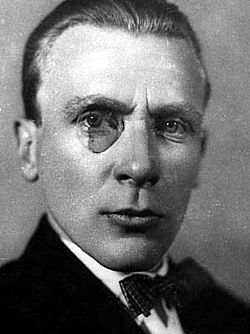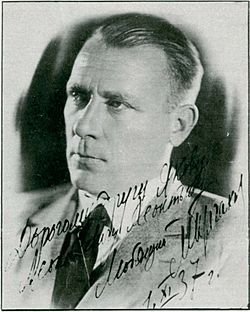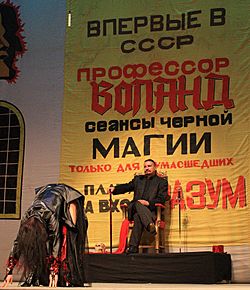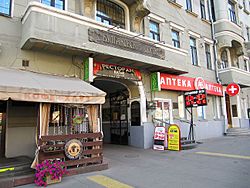Mikhail Bulgakov facts for kids
Quick facts for kids
Mikhail Bulgakov
|
|
|---|---|

Mikhail Bulgakov, 1930 or earlier
|
|
| Occupation | Novelist, Playwright |
| Genre | Fantasy, Satire |
Mikhail Bulgakov (born May 15, 1891 – died March 10, 1940) was a famous Russian writer and playwright. He lived and wrote in the early 1900s.
He is most famous for his novel The Master and Margarita. Many people consider it one of the best books of the 1900s.
Much of Bulgakov's writing is called magic realism. This means that fantasy or magical things happen in what seems like a normal, everyday story.
Contents
Bulgakov's Early Life and Career
Mikhail Bulgakov was born in Kiev, Ukraine, on May 15, 1891. His father was a professor. From a young age, Bulgakov loved Russian and European books. He also enjoyed the theatre and opera.
In 1913, Bulgakov married Tatiana Lappa. When World War I started, he joined the Red Cross as a doctor. He was sent to areas with heavy fighting. He was injured at least twice during the war.
In 1916, he finished medical school at Kiev University. Later, he joined the White Army with his brothers. They fought against the communists who were taking control of Russia. Bulgakov also fought in the Ukrainian People's Army.
After the Russian Civil War, Mikhail and his brothers went to the Caucasus region. Mikhail worked as a journalist there. Many of his family members left Russia for Western Europe. However, Bulgakov could not leave because he had typhus, a serious illness.
The injuries he got in World War I caused him a lot of pain for years.
Becoming a Writer in Moscow
Bulgakov decided to stop being a doctor. He was sure he wanted to be a writer. In 1921, he moved to Moscow with his wife, Tatiana.
He later divorced Tatiana and married Lyubov' Belozerskaya in 1924. Bulgakov published several works in the early 1920s. But by 1927, some people started to criticize his writing. They said he was writing against the Soviet government.
By 1929, Bulgakov's writing career faced big problems. The government used censorship to stop his books and plays from being published in the USSR.
In 1931, Bulgakov married again, to Yelena Shilovskaya. Yelena was the inspiration for one of the main characters in his most famous novel. This was The Master and Margarita. For the last ten years of his life, Bulgakov kept writing. He wrote novels, plays, and translated other works.
However, many of his new works could not be published in the USSR. Those that were published often received strong criticism.
Challenges with the Soviet Government
Bulgakov was unhappy that the Soviet system stopped his works from being published. He wrote a letter to the Soviet government. In it, he asked for permission to leave the country. He even spoke directly to Joseph Stalin on the telephone. He asked Stalin if he could leave the USSR. Stalin's reply suggested that if Bulgakov tried to leave, he would be killed.
Stalin did allow Bulgakov to work at a small theatre in Moscow. Bulgakov later worked at the Moscow Art Theatre. But the Soviet system still did not let him write freely. This, along with not being allowed to visit his family abroad, made Bulgakov very sad.
Bulgakov died on March 10, 1940. He passed away due to kidney problems. He was buried in the Novodevichy Cemetery in Moscow.
The Master and Margarita Novel
The Master and Margarita is a satire about Soviet society. A satire uses humor, irony, or exaggeration to criticize people or ideas. The novel tells two stories that switch back and forth chapter by chapter.
One story is about the Devil visiting Moscow in modern times. The other story is about Pontius Pilate, a Roman governor from ancient times. These two stories are connected by Satan himself. They are also linked by the Master and his devoted lover, Margarita. The Master is a writer who is very upset. His historical novel about Pontius Pilate was rejected by the Soviet literary committee.
When people first read the novel, they were surprised by its bold satire. They also found its comedy very funny.
Through the story, Bulgakov explores deep ideas about life. He looks at the difference between good and evil. He also writes about innocence and guilt, and courage and cowardice.
Bulgakov started writing the novel in 1928. He burned the first copy of the book in 1930. He felt there was no future for him as a writer in the Soviet Union. He started working on it again in 1931. The second version was finished in 1936. By then, all the main parts of the final story were in place. The third version was done in 1937.
Bulgakov kept working on the book with help from his wife. But he had to stop working on the fourth version four weeks before he died in 1940.
A changed version of the book was first published in a magazine in 1966 and 1967. About 12% of the text was removed, and more was changed. The parts that were left out were shared secretly. In 1967, a publisher in Germany printed a version with these missing parts added back in.
In the Soviet Union, the first complete version was published in 1973. In 1989, the most complete version was prepared. It used all the different handwritten copies of the novel.
The novel is like Bulgakov's own life story. Bulgakov is like the Master in the book. The difficulties the Master faces are very similar to Bulgakov's own problems. Margarita is based on Yelena Shilovskaya, who became his third wife. The Master burning his book is exactly what Bulgakov did. He did it for the same reasons: sadness and frustration. A state literary committee stopped his book from being published, just like in the novel. Bulgakov was also very interested in the meeting between Christ and Pontius Pilate.
Bulgakov never lived to see his novel published. He also did not get to enjoy his fame after the war. He died from a kidney problem on March 10, 1940. His father had the same disease, and Bulgakov had long expected this fate.
The Master and Margarita in Other Media
This famous novel has been made into many different forms. It has been used for films, stage plays, operas, ballets, and television shows.
Other Novels and Short Stories by Bulgakov
- The White Guard (1926): This novel is about a White Army officer's family. It shows their life in Kiev during the Russian Civil War.
- Heart of a Dog (1968): This is a sharp satire about the "New Soviet man." It was written in 1925 when Communism seemed to be getting weaker in the Soviet Union.
- A country doctor's notebook (1975)
- The Fatal Eggs (1993): This was a science fiction story written in 1924. It became popular but was criticized by some. They saw it as a satire of the Russian Revolution of 1917.
Plays by Bulgakov
- The early plays of Mikhail Bulgakov, 1990
- Zoya's apartment: a tragic farce in three acts, 1991
Biography by Bulgakov
- Life of Mr. de Molière, 1962
Images for kids
-
Bulgakov with Soviet writers Yury Olesha and Valentin Katayev
See also
 In Spanish: Mijaíl Bulgákov para niños
In Spanish: Mijaíl Bulgákov para niños









